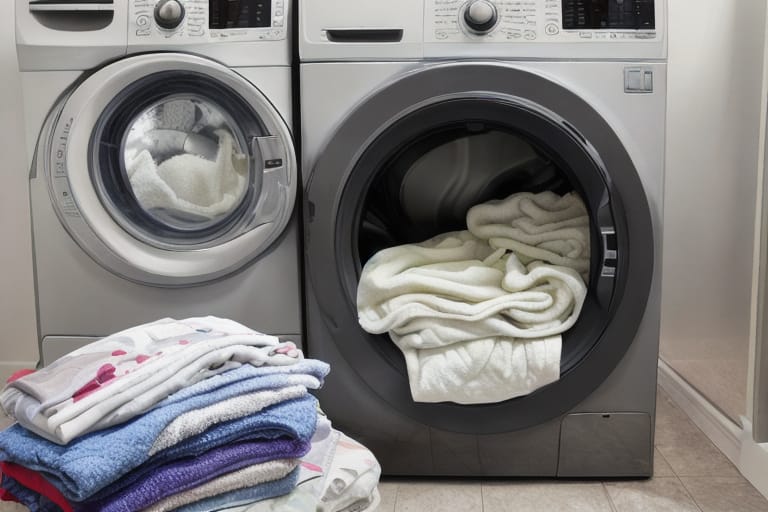You just invested in a luxurious down-filled comforter for your bed. But now you need to clean it, and you worry that washing might ruin your pricey bedding and compromise comfort. Rest assured that with proper techniques you can safely clean your down comforter at home and maintain its loft, warmth and durability over many years.
This beginner’s guide covers everything you need to know about washing down bedding properly, comparing methods like machine washing, dry cleaning, hand washing and spot cleaning to handle different comforter types. Follow the care instructions outlined below to keep your down comforter clean, fluffy and good as new.
Why Proper Cleaning Matters for Down Comforters
Unlike regular blankets and quilts, down-filled comforters require special care when cleaning. The delicate feather filling consists of fluffy down clusters that provide exceptional insulation and breathability. But they can easily lose their loft and become lumpy or misshapen if washed improperly.
Maintaining your down comforter’s quality through careful laundering ensures:
- Continued warmth and comfort: Keeping down intact and fluffy maintains its insulating properties to trap heat.
- Prolonged lifespan: Gently cleaning preserves the comforter, avoiding deterioration from dirt, oils and sweat buildup.
- Odor elimination: Washing eliminates odors from body sweat and oils that accumulate naturally.
- Allergy and asthma relief: Removing dust mites, mold and other allergens through washing provides relief for sensitive individuals.
Following the best practices below keeps your bedding sanitary and comfortable for years of blissful sleep.
Common Myths and Misconceptions
Many myths persist about washing down, potentially dissuading comforter owners from attempting this important maintenance task. Here are some common misconceptions debunked:
Myth: Machine washing will destroy the down and ruin the comforter’s fluffiness.
Fact: With the proper gentle cycle, washing machine and drying methods, you can safely clean most down comforters at home without damage.
Myth: Home washing will strip the natural oils from down and reduce insulating ability.
Fact: Natural oils regenerate over time after washing and have minimal impact on warmth. Proper drying restores fluff.
Myth: Dry cleaning is always safer for cleaning delicate down bedding.
Fact: Reputable dry cleaners with expertise in down can deliver great results. But home washing is equally effective when done carefully by hand or machine.
Now let’s explore your down comforter anatomy, compare cleaning methods, outline best practices for home laundering, and solve common issues that may arise.
Anatomy of a Down Comforter
Before cleaning, it helps to understand what makes your down-filled bedding so soft and warm.
Types of Down Fill
The insulating fill inside a comforter consists of delicate clusters of fluffy down feathers from ducks or geese. These soft, airy filaments trap body heat. Down comes in two varieties:
- Duck down– harvested from ducks, featuring superior lofting power to retain maximum fluff. Pricier but more durable.
- Goose down– plush down sourced from mature geese. Very warm with good moisture resistance but less affordable.
Many comforters also add feathers for increased weight and structure. More affordable synthetic downs made from microfibers like polyester provide cost-effective vegan alternatives.
When shopping, check the fill power rating from 300-900+ to gauge quality and warmth. Higher numbers indicate more insulation.
What Impacts Down Comforter Longevity
With proper maintenance, a high-end down comforter can last over 10 years. Several factors influence lifespan:
- Quality of materials– Higher thread count, rip-stop fabrics and premium down resist deterioration better.
- Care and handling – Frequent washing, proper machine drying settings, delicate handling and correct storage preserve insulation, fabric integrity and cleanliness.
- Use frequency – Primary beds see more wear than guest room bedding used occasionally. Rotate comforters to distribute wear evenly.
Understanding typical down comforter anatomy, fill properties and lifespans helps inform appropriate cleaning approaches. Next let’s compare popular washing methods.
Dry Cleaning vs Machine Washing Down
You have several options for cleaning your down-filled bedding, each with pros and cons. Evaluate these choices below to pick the method that suits your needs and comforter type best.
Dry Cleaning Overview
Reputable professional dry cleaners properly trained in down provide quality cleaning results. The non-aqueous solvent-based process involves:
- Pre-inspection and spot treatment
- Gentle machine agitation in chemical solvents
- Rinsing in special finishing solvents
- Drying in commercial machines
- Additional touches like adding fabric softener
The Good: No hassle, high quality, experts handling delicate materials. May qualify for manufacturer warranties.
The Bad: More expensive, chemicals can damage fabric over time, environmental impact concerns. Access and scheduling hurdles.
Cost Range: $40-$100 per king-size comforter.
At-Home Machine Washing
With care, prevention of leaks, and low-agitation settings, home washing machines effectively clean down comforters. Follow key steps:
- Choose mild powder detergent for delicates
- Set machine to delicate cycle with cold water
- Use tennis balls to prevent clumping
- Multiple rinse cycles to flush detergent
- Low-heat tumble dry with dryer balls
The Good: Convenience, total control, quick access, budget-friendly
The Bad: Easy to shrink/damage if done improperly, bulky to handle
Cost Range: $8-$15 per wash (water, electricity, supplies)
Hand Washing Technique (Best for Antiques)
For vintage or antique down bedding, gentle hand washing utilizes a bathtub or large sink basin:
- Fill with lukewarm water and diluted mild soap
- Submerge and soak comforter
- Agitate and compress gently by hand
- Drain dirty water and refill for rinsing
- Roll in towels to compress water out
- Reshape and air dry on a flat surface
The Good: Extremely gentle for fragile materials
The Bad: Very labor intensive and slow drying
Cost Range: $0 besides mild soap and water
Choose the method that best aligns with your down comforter attributes, available facilities, budget and cleaning preferences. Proceed to the appropriate in-depth cleaning guide below.

Step-By-Step Guide for Home Machine Washing
Convenient in-home washing only risks down damage if done improperly. Follow these best practice guidelines for safety and optimum results:
1. Inspect and Pretreat Stained Areas
Apply a small amount of mild upholstery cleaner, hydrogen peroxide or diluted vinegar to any visible stains on the outer fabric of your down comforter. Let it soak for 10-15 minutes. Then dab gently with a microfiber cloth or soft brush to lift stains before main wash.
2. Choose a Front-Loading Machine
Top load agitator models damage delicate materials – the central column churns too vigorously. A front load washer provides a gentler tumble action for down. Look for large capacity models, at least 4 cubic ft.
3. Select the Delicate Cycle
Set your washing machine to the most delicate cycle option with cold water on a low or medium soil setting. This slower agitation and spinning prevents rips, leakage and lumpiness.
Delicate Cycle Specifications
- Slowest agitation speed
- Cold water under 80°F
- Extra rinse cycle
- Low-speed spin
4. Use Laundry Bags
Place your comforter inside either a large mesh bag or two thicker cotton bag alternatives to prevent friction damage:
- Mesh laundry bags– Breathable fabric, max fill lines prevent overloading.
- Pillowcases – Use two tied shut to secure comforter. Avoid zippers.
- Sheets – Protects fabric well though less stretch.
5. Add Powder Laundry Detergent
Powder detergent for delicates dissolves best in cold water cycles versus liquid. Measure as directed on packaging for standard sizes:
- 1 tbsp for standard washers
- 1.5 tbsp for larger high-efficiency machines
Avoid detergents with:
- Brightening agents
- Strong perfumes
- Fabric softeners
These additives leave residue and accelerate down degradation.
6. Include Tennis Balls
Adding 2-3 tennis balls to the wash drum balances the load, rubbing your comforter to break up clusters for even cleansing. The gentle friction prevent lumping without damaging the down.
7. Use Low-Heat Drying Cycles
Move your comforter immediately from the washer to the dryer before it sits wet, as moisture damage and mildew may develop.
Keep dryer heat under medium to prevent over-drying the down. Choose the delicate, low heat, air fluff or similar low temperature cycle option.
8. Add Dryer Balls
Wool or plastic ball aids lift and separate down clusters while drying, restoring maximum loft. They also speed airflow.
9. Repeat Fluffing
Stop the dryer every 20 minutes to manually redistribute and fluff the down filling. Break up any damp sections and return to tumbling. Repeat fluffing 2-3 times for even drying.
Follow these home washing best practices carefully to keep your down bedding intact for years of comfort. Next we’ll explore drying and storage methods.
Proper Drying Practices
Drying a freshly washed down comforter requires care to restore loft and prevent damage:
Method #1: Air Drying
Lay your comforter flat across towel-covered surfaces or drying racks outside or in a well-ventilated room. Reshape and fluff periodically until fully dry. Keep away from direct sunlight to avoid fading.
Pros:
- Maximally gentle and safe
- Prevents shrinkage
- Energy efficient
- Low cost
Cons:
- Very time intensive
- Dependent on climate conditions
- Risk of moisture damage if humidity is high
- Limited indoor space needed
Method #2: Machine Drying
Use an electric or gas dryer on delicate setting with dryer balls as covered in the home washing guide above.
Pros:
- Fast, convenient
- Restores loft well
- No reliance on weather
Cons:
- Potential heat damage if too hot
- Energy consumption
- Risk of uneven drying
Storing for Optimized Longevity
Proper storage helps your cleaned down comforter last over a decade rather than compress and degrade. Follow these best practices:
- Allow the comforter to fully dry before long-term storage
- Fold flat or loosely roll up
- Avoid overly tight vacuum seal bags
- Store in cool, dark spaces like chest or closet
- Use breathable cotton cases or sheets as a protective outer layer
- Wash linens and ticking every 1-2 years if storing long term
After seasonal storage, fluff in the dryer with new dryer balls to re-loft before first use.
Rotate your primary comforter seasonally with secondary ones used in guest rooms or summer cabins to distribute wear evenly across any bedding collection.

Frequency Asked Questions
Still nervous about cleaning your own down comforter at home? These common concerns have easy solutions:
My down shifted and became lumpy after washing. How do I fix this?
In the dryer, add a couple clean sneakers and set to high heat for 20 minutes, stopping to redistribute and break up lumps every 5 minutes. The shoes help knock down back into place without damage during agitation.
How do you wash large or oversize king comforters at home?
Look for front load washer models over 4.5 cubic ft or commercial sized. Use a king-size duvet cover fastened shut around the comforter to contain it or extra-large mesh laundry bags. Wash individual halves if needed.
Help! My down comforter shrunk. Can I reshape it back to size?
Soak in lukewarm water with hair condition in the tub for 20 minutes until saturated. Weight down the corners while wet as it air dries, keeping to original dimensions as much as possible. May not restore completely but will help improve sizing.








